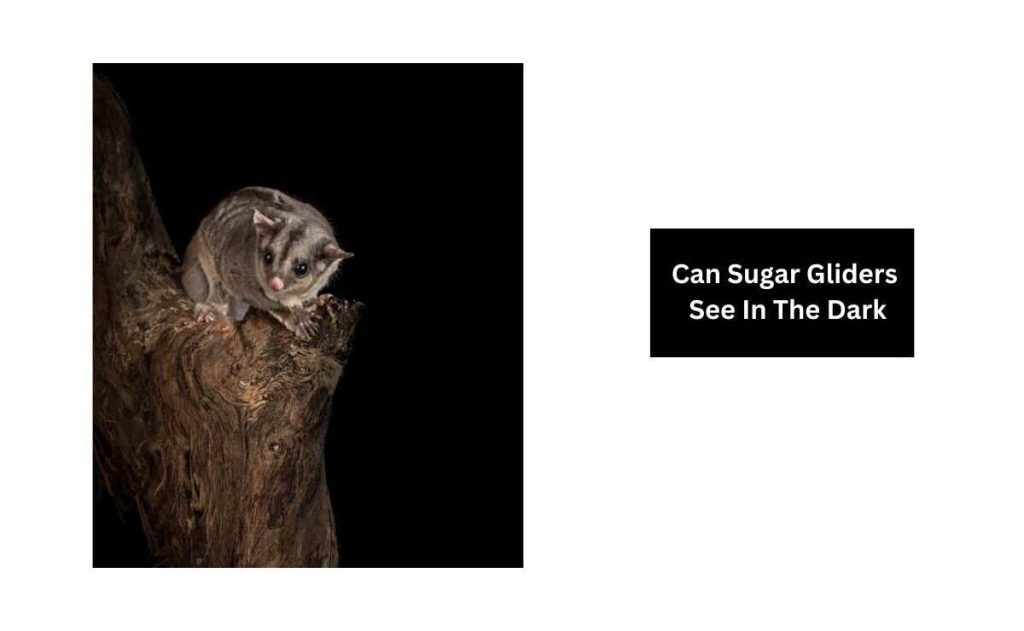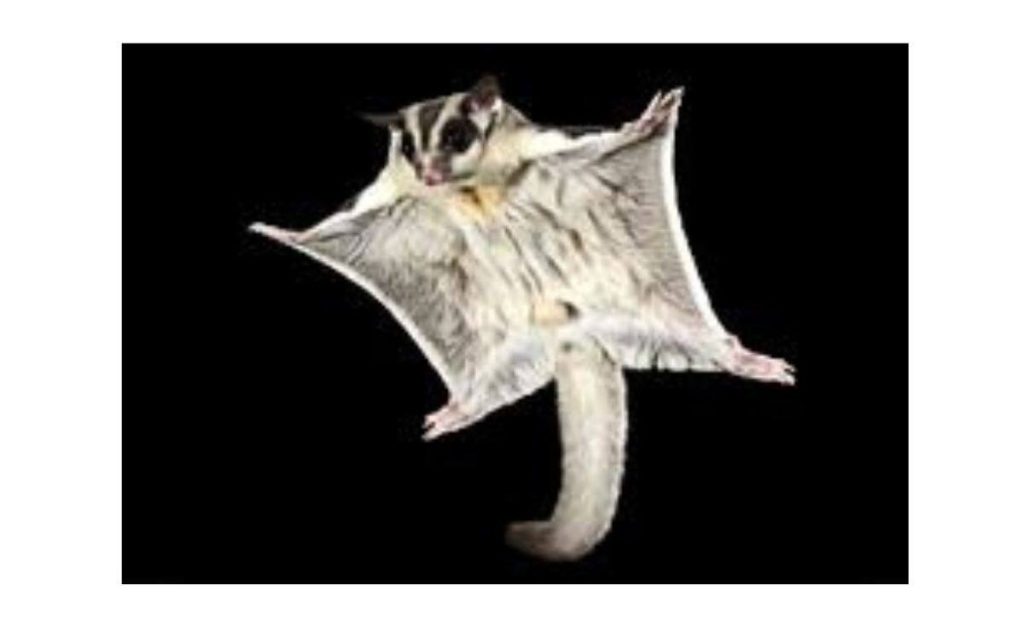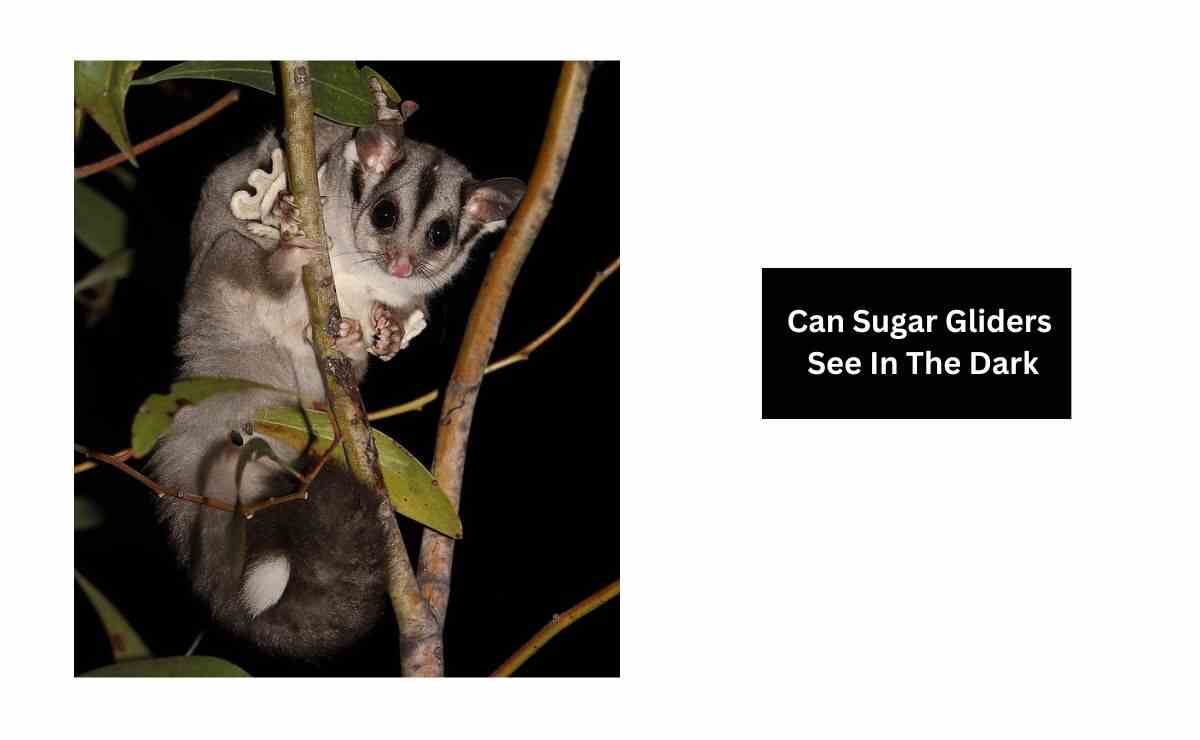Sugar Gliders can make great pets for the right owner. These small marsupials are native to Australia and now have become popular pets in other parts of the world. Since they are exotic pets, many don’t know about their features. So, many people ask can sugar gliders see in the dark?
Yes, sugar gliders can see in the dark. They are particularly nocturnal marsupials. So they have an excellent night vision to help them navigate and find food in the dark. Their busy time is night. Sugar gliders sleeping behavior mostly depends on these factors.
Can Sugar Gliders See In The Dark?

Sugar gliders are nocturnal creatures with excellent night vision. They have large eyes that allow for a high level of light sensitivity. Their eyes are also positioned more towards the front of their head, giving them a wider field of vision compared to other nocturnal animals. This helps them to better detect movement and potential predators in their surroundings.
While sugar gliders have good night vision, they are not able to see in complete darkness. They still rely on some source of ambient light to see their surroundings. In addition to their vision, sugar gliders also have a well-developed sense of hearing and a keen sense of smell, which they use to navigate and locate food in their environment.
So, while sugar gliders do have the ability to see in low light conditions, it is important to provide them with appropriate lighting in their habitat to ensure their well-being and to aid in their natural behaviors.
Nocturnal Sugar Gliders In The Wild

Sugar gliders are most active during the night and sleep during the day. This behavior is a survival adaptation that helps them avoid predators, as the cover of darkness provides them with better protection in the wild.
If you’re considering having a sugar glider as a pet, it’s essential to grasp their nocturnal nature. They typically start their activities a few hours after dusk, remaining active until dawn.
Indeed, sugar gliders follow a nocturnal schedule, sleeping for approximately 12 hours during the day and remaining active for the remaining 12 hours throughout the night.
This schedule aligns with their natural instincts and allows them to forage for food while minimizing the risk of being spotted by predators. Animals, birds like snakes, cats, lizards, and hawks, all prey on these tiny sugar gliders in the wild. So nighttime is safe for them.
As a potential sugar glider owner, it’s crucial to acknowledge the adjustments this nocturnal lifestyle might require. Unlike humans, sugar gliders operate on a different sleep-wake cycle. This could mean that your furry friend is most active when you’re ready for a good night’s sleep.
Moreover, be prepared for the potential noises they may make, such as barking sounds, which are a part of their communication repertoire.
Taking care of a nocturnal pet can pose some challenges, especially for individuals accustomed to diurnal animals like dogs and cats. So you have to understand and respect the sugar glider’s natural behavior.
As a responsible owner, you should provide an environment that accommodates their nocturnal activities and be patient and adaptable to their unique schedule.
Sleeping Habits of Nocturnal Sugar Gliders
Sugar gliders display a sleep pattern that goes beyond a simple 12-hour cycle. Contrary to a straightforward day-night sleep routine, these tiny marsupials spend approximately 15 hours in a 24-hour cycle sleeping.
Scientific research delves into the intricacies of their sleep behavior, revealing a blend of nocturnal and diurnal patterns influenced by light levels and social interactions.
In their natural habitat, sugar gliders tend to rest during the daylight hours, in quiet spots to evade predators. The night transforms them into more active creatures as they go outside in search of food, particularly enjoying treats like sap and nectar.
Interestingly, even during the darkest hours, they indulge in short naps, reserving their peak activity for the period after sunset and just before sunrise. This behavioral rhythm intensifies during breeding seasons or when caring for their young.
While many individuals cherish sugar gliders as pets, their sleep patterns pose significant challenges. In captivity, sugar gliders may deviate from their natural sleep routines due to various factors.
Research suggests that the altered sleep patterns observed in captive sugar gliders could be linked to changes in brain chemistry and behavior. For instance, captive sugar gliders exhibit increased daytime activity, potentially a response to heightened stress levels or variations in their environment.
How To Adjust Sugar Gliders Sleep Pattern?
Trying to match their sleep schedule with ours might not be the best idea because it doesn’t match how they naturally are. Research tells us that it’s crucial to make their living space comfortable to avoid disturbing their rest.
Sugar gliders are nocturnal animals by nature, meaning they are most active during the night. However, in some cases, it may be necessary to adjust their sleep patterns to better accommodate their human owners’ schedules or to address certain behavioral issues.
The first step in adjusting a sugar glider’s sleep pattern is to gradually shift their waking and sleeping times. Start by gradually waking them up earlier each day and keeping them awake for longer periods during the day. This can be done by gently stimulating them, providing light in their sleeping area, and offering engaging activities and toys to keep them active.
Similarly, you can start dimming the lights and creating a quieter and more relaxed environment in the evening to encourage them to sleep longer during the night.
It’s important to note that sugar gliders are sensitive animals, and sudden changes to their routine can cause stress and anxiety. It is recommended to make these adjustments gradually over a period of several weeks to minimize any negative impacts on their well-being.
You should provide a consistent and enriched environment for sugar gliders can also help regulate their sleep patterns. This includes offering a proper diet, ensuring they have plenty of space to exercise and explore, and providing stimulating toys and activities during their waking hours.
Is Bright Light Harmful To Sugar Gliders?
One significant concern for sugar glider owners is the potential harm caused by exposure to bright light. Current research indicates that prolonged exposure to bright light can lead to eye damage and disrupt the biological activity and sleep cycles of these nocturnal creatures.
Remember that sugar gliders, even in captivity, are wild animals. As responsible owners, it is our duty to care for them appropriately. This includes understanding the impact of light on their well-being.
Sugar gliders possess a remarkable nocturnal vision that is finely tuned to their natural habitat. With large, wide-set eyes, they can navigate and forage for food effectively during the night.
Their dark brown eyes see the world in shades of gray, with a unique ability to detect the color red. Additionally, they have a fascinating adaptation – the ability to excrete a milky substance from their tear ducts, aiding in cleaning and grooming their eyes.
When considering the lighting for your sugar glider’s environment, it’s essential to avoid blue light sources. These can be not only disruptive and stressful for sugar gliders but also potentially harmful to their health.
Red light should also be approached with caution. The optimal choice for sugar gliders is infrared illumination (IR), as it has no adverse effects on their behavior.
Final Words
Sugar gliders are like nighttime experts with their fantastic night vision. Their big eyes, set wide on their tiny faces, give them the power to see really well in the dark. They use this super skill to navigate and find food during their nightly adventures in the night.
So, in a nutshell, you should have a better understanding of their nature that helps you take better care of them.
Also Read
